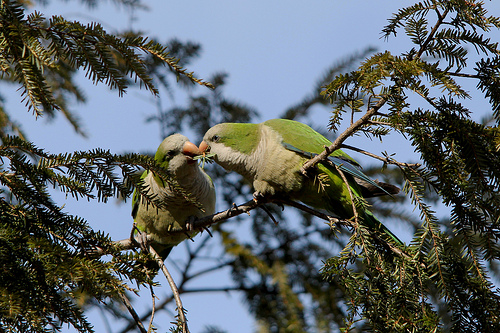Urbanakeets
 Tuesday, December 6, 2011 at 9:58
Tuesday, December 6, 2011 at 9:58  Monk parakeets at Green-Wood Cemetery. Photo: Jeremy SetoIt’s been more than 40 years since the first monk parakeet, a chatty, bright green South American parrot popular with pet owners, was first spotted flitting through Chicago’s Hyde Park. Even in 1968, it was a bit of an oddity. Since then, however, the introduced species has become a popular fixture in the Chicago area, attracting plenty of media attention. Now, a new survey takes a look at just how these urban parakeets are adapting city life.
Monk parakeets at Green-Wood Cemetery. Photo: Jeremy SetoIt’s been more than 40 years since the first monk parakeet, a chatty, bright green South American parrot popular with pet owners, was first spotted flitting through Chicago’s Hyde Park. Even in 1968, it was a bit of an oddity. Since then, however, the introduced species has become a popular fixture in the Chicago area, attracting plenty of media attention. Now, a new survey takes a look at just how these urban parakeets are adapting city life.
“Monk parakeets (Myiopsitta monachus) are the most abundant and widely distributed of the naturalized parrots in the United States,” a team led by Stephen Pruett-Jones of the University of Chicago writes in Urban Ecosystems. Since they were first spotted in the wild in New York in 1967, populations have become established from Florida to California. Two habits have helped the birds spread, the authors note: They build their own nests, instead of relying on natural cavities; and they easily shift to new food sources – such as bird feeders stuffed with seed – when necessary. Those habits helped monk populations grow nationally, they note. And the parakeet boom even raised concerns that the birds would become a major agricultural pest, triggering a brief – and largely unsuccessful – effort to control their numbers. “Recently, however, the population in the United States appears to be declining in numbers,” the researchers note, although the reasons aren’t clear.
To see if that slump was hitting Chicago’s monks too, the researchers reached out through the media to city residents, asking them to report any sightings of parakeets or their nests. Then, they integrated those reports into a range of more scientific surveys conducted by local ornithologists. Together, the surveys provided a long-term look at Chicago’s parakeet populations.
The numbers suggest that “the species became established in the Hyde Park neighborhood of Chicago in 1979 and this population grew exponentially and expanded over the next 25 years,” the authors write, reaching about 300 birds in the 2000s. In 2005, however, “the population in Hyde Park began to rapidly decline,” reaching just 84 birds in 2010.
Monk numbers in the greater Chicago region, however, “have never declined but have continued to grow,” the authors note. “This growth is simply occurring in areas other than Hyde Park.” A 2010 survey, for instance, found 389 active nest chambers, including some in distant suburbs, suggesting at least 778 birds currently live in the greater Chicago region.
And the parakeet’s population and range is likely to keep growing, the researchers predict. “Every year we receive reports of parakeets during the winter in localities far to the west of Chicago where the birds are not yet breeding,” they note. “We suspect that these sightings are either birds at established nesting colonies that are traveling great distances to forage, or of dispersing birds looking for suitable sites to breed the following spring. Either way, these sightings suggest to us that the birds will eventually be breeding in these areas.”
That suggests, the authors conclude, that “the monk parakeet will continue to be both an interesting and controversial species and one that highlights the complex interaction between public sentiment, public policy, and biology. There is no sign that this controversy is decreasing and in fact, we anticipate it increasing dramatically in states where the species is common.”
 Myiopsitta monachus - Monk Parakeet | in
Myiopsitta monachus - Monk Parakeet | in  Urban parrots
Urban parrots 
